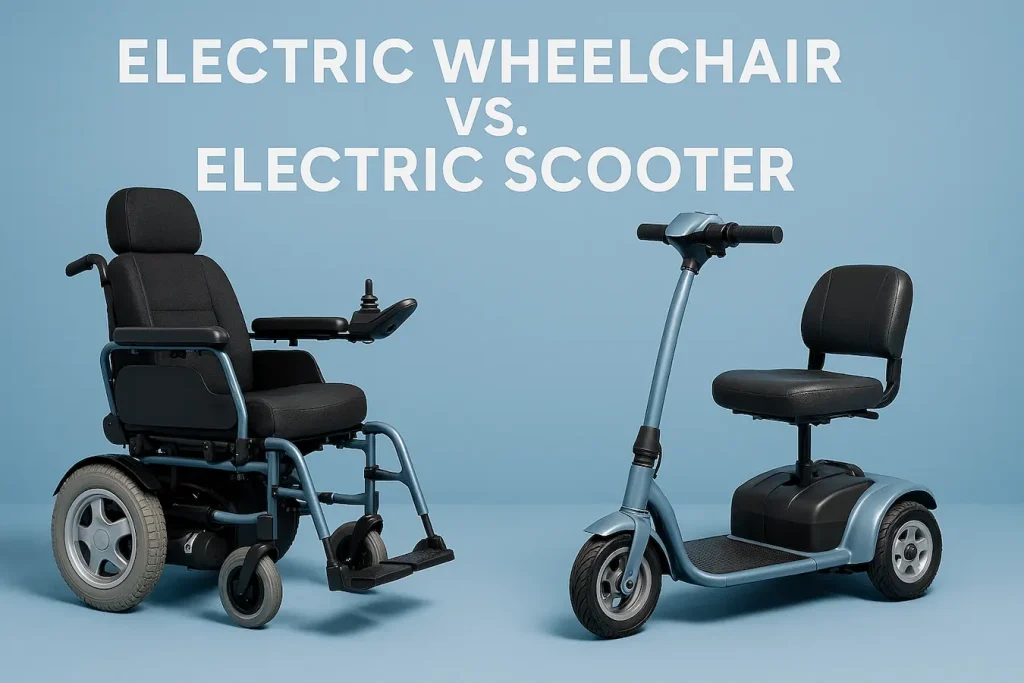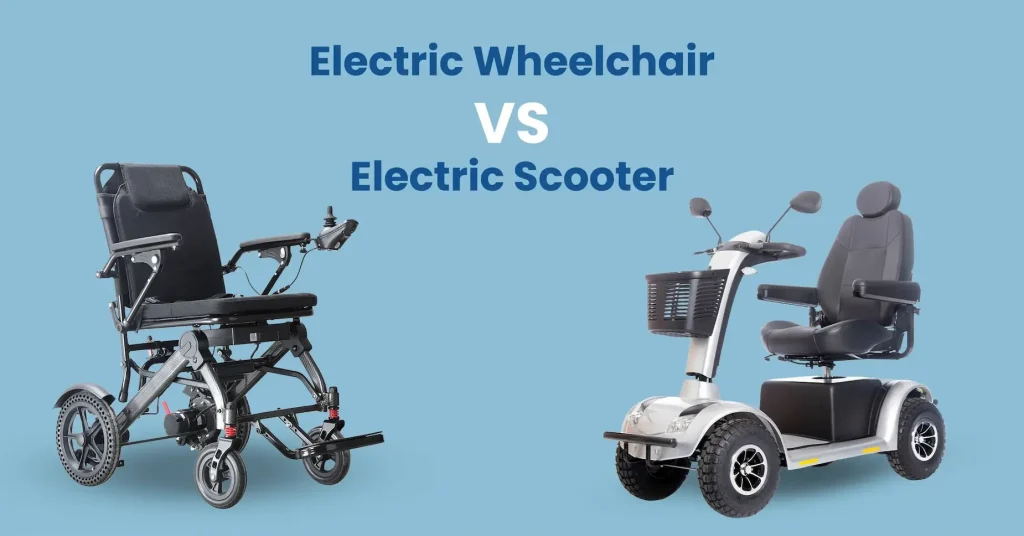For many seniors, walking long distances is not that easy. Mobility devices can make daily life possible again. They restore freedom, comfort, and safety. Yet, choosing between electric Scooter vs electric Wheelchair is confusing.
This guide explains features, costs, and safety. It also covers Medicare and Medicaid rules. By the end, you’ll know which option fits best for your needs.
Electric Scooters Explained
An electric scooter is a motorized scooter built for people who can sit upright and steer. It works like a bicycle with a handlebar, called a tiller.
Steering: Controlled with a tiller. simple to learn.
Seats: Swivel chairs. Also, padded and supportive.
Range: 10–30 miles on a charge.
Portability: Folding mobility scooters can fit into car. While lightweight scooters are easy to carry.
Types:
Scooters for seniors – designed for ease and safety.
Portable mobility scooters – foldable, small, easy to carry.
Medical scooters – built for daily use with comfort in mind.
Used mobility scooters – cheaper choice, but check battery health.
Benefits
Easy to use outdoors.
Many models suit different budgets.
Can be covered by Medicare or Medicaid.
Best mobility scooters offer speed and longer range.
Drawbacks
Need upper-body control for steering.
Not great for tight indoor spaces.
Large models can be heavy to move.

Electric Wheelchairs Explained
An electric wheelchair, also called a power wheelchair, helps people with limited strength. It uses a joystick instead of a tiller. This makes it easier to control indoors.
Features of Electric Wheelchairs
Joystick control: Simple and requires little effort.
Comfort: Adjustable seating, recline, and tilt options.
Range: Around 10–20 miles per charge.
Varieties:
Folding electric wheelchair – compact and easy to store.
Lightweight electric wheelchair – portable, good for travel.
Portable electric wheelchair – small and durable.
Best electric wheelchairs – advanced features, longer battery life.
Electric wheelchairs for adults – daily use models with sturdy frames.
Benefits
Works well indoors with tight turns.
Great for people with little strength.
Can be prescribed and covered by Medicare or Medicaid.
Offers high safety with stable seating.
Drawbacks
Costs more than scooters.
Heavier and less portable without lifts.
Needs regular maintenance.
Medicare and Medicaid Coverage
Many people wonder if electric scooters or electric wheelchairs are covered by insurance. Medicare Part B may help pay if a doctor confirms medical need. You must show you can safely use the device. Not all models are covered.
Medicaid also offers support in most states. Coverage rules can differ depending on the program. Approval usually requires a doctor’s prescription and proof of medical need. Some states may require prior authorisation before purchase.
Both programs aim to regain mobility. They make different medical equipment affordable. Always check with your doctor and insurance before you buy it.
Key Differences
Here’s a quick side-by-side view:
| Feature | Electric Scooter | Electric Wheelchair |
|---|---|---|
| Control | Tiller steering | Joystick steering |
| Portability | Folding options | Folding options too |
| Cost | $800 – $3,000 | $1,500 – $5,000+ |
| Indoors | Limited use | Very effective |
| Outdoors | Works well | Works but slower |
| Coverage | Medicare Part B | Medicare Part B |
| Strength Needed | Moderate | Very little |
How to Choose
Ask yourself:
Do you have enough strength to steer?
Yes → A mobility scooter fits better.
No → An electric wheelchair is safer.
Where will you use it most?
Outdoors → Go with a mobility scooter.
Indoors → Choose an electric wheelchair.
Do you need portability?
Yes → Pick a foldable mobility scooter or folding electric wheelchair.
No → A full-size model may give better comfort.
What’s your budget?
Limited → Look at used mobility scooters or electric wheelchairs for sale.
Flexible → Get the best electric wheelchair or lightweight mobility scooter.
Conclusion:
Both scooters and wheelchairs are great steps toward independence. All depends on your health, strength, and lifestyle.
A mobility scooter suits people with fair strength. Suitable for outdoor travel. An electric wheelchair suits those who need stronger support indoors. Also, outdoor sometimes.
Always check if Medicare or Medicaid can help with costs. Test different models. Ask your doctor and think about your daily routines. The right device is not just about movement. It’s about freedom, dignity, and safety.

